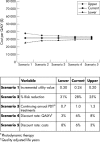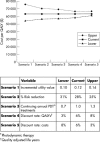Cost utility of photodynamic therapy for predominantly classic neovascular age related macular degeneration
- PMID: 15258009
- PMCID: PMC1772258
- DOI: 10.1136/bjo.2003.039131
Cost utility of photodynamic therapy for predominantly classic neovascular age related macular degeneration
Abstract
Background/aim: Age related macular degeneration (AMD) is the leading cause of severe vision impairment and blindness in older people throughout the developed world and currently affects around 420 000 UK citizens. Choroidal neovascularisation (CNV) is treatable with photodynamic therapy (PDT) but is expensive at over pound 1200 per treatment. The aim of this study was to assess the cost utility of PDT for better eye, predominantly classic, subfoveal choroidal neovascular lesions secondary to AMD.
Methods: Cost utility analysis (CUA) was conducted to estimate the cost effectiveness of PDT for scenarios involving reasonable (6/12) and poor (6/60) visual acuity. The models incorporated data from the Treatment of Age-related Macular Degeneration with PDT (TAP) Study and patient based utilities. The incremental CUA was based on decision analytical models, comparing treatment to a placebo comparator. Extensive one way sensitivity analysis of parameters was conducted to determine the robustness of the model. A discount rate of 6% was used for costs and quality adjusted life years (QALY).
Results: Model 1: in people with reasonable initial visual acuity, the cost utility of treating applicable neovascular AMD lesions was pound 31 607 per QALY saved, with a sensitivity analysis range from pound 25 285 to pound 37 928. Model 2: in people with poor initial visual acuity, the cost utility was pound 63 214 per QALY saved, with a sensitivity analysis range from pound 54 183 to pound 75 856.
Conclusions: PDT treatment is the only available treatment for some forms of neovascular ("wet") AMD. Under these assumptions, PDT can be considered moderately cost effective for those with reasonable visual acuity but less cost effective for those with initial poor visual acuity. These findings have implications for ophthalmic practice and healthcare planning.
Figures
Comment in
-
Value based medicine.Br J Ophthalmol. 2004 Aug;88(8):979. doi: 10.1136/bjo.2003.040030. Br J Ophthalmol. 2004. PMID: 15258007 Free PMC article. No abstract available.
References
-
- Wang JJ, Foran S, Mitchell P. Age-specific prevalence and causes of bilateral and unilateral visual impairment in older Australians: the Blue Mountains Eye Study. Clin Experiment Ophthalmol 2000;28:268–73. - PubMed
-
- Wright SE, Keeffe JE, Thies LS. Direct costs of blindness in Australia [in process citation]. Clin Experiment Ophthalmol 2000;28:140–2. - PubMed
-
- Chiang YP, Bassi LJ, Javitt JC. Federal budgetary costs of blindness. Milbank Q 1992;70:319–40. - PubMed
-
- Wang JJ, Mitchell P, Smith W, et al. Impact of visual impairment on use of community support services by elderly persons: the Blue Mountains Eye Study. Invest Ophthalmol Vis Sci 1999;40:12–19. - PubMed
Publication types
MeSH terms
LinkOut - more resources
Full Text Sources
Medical
Miscellaneous


